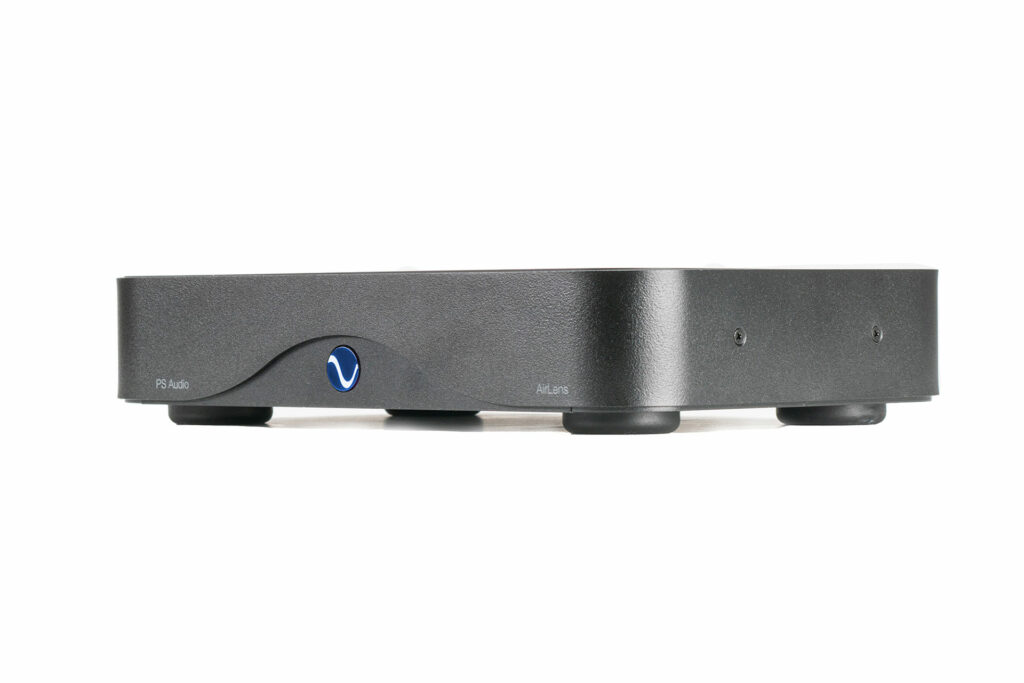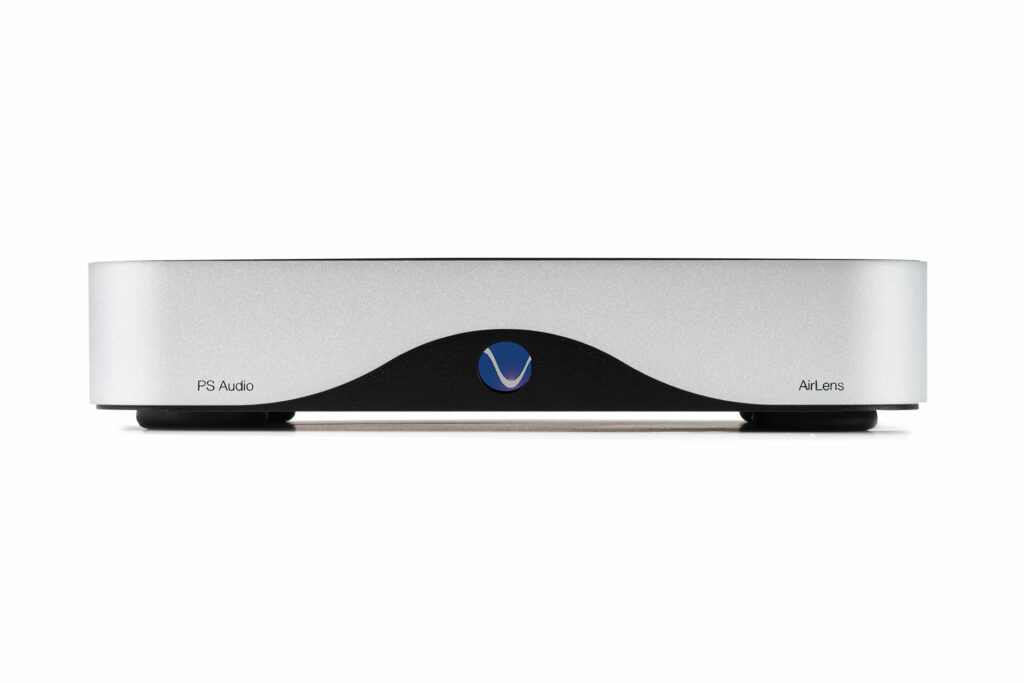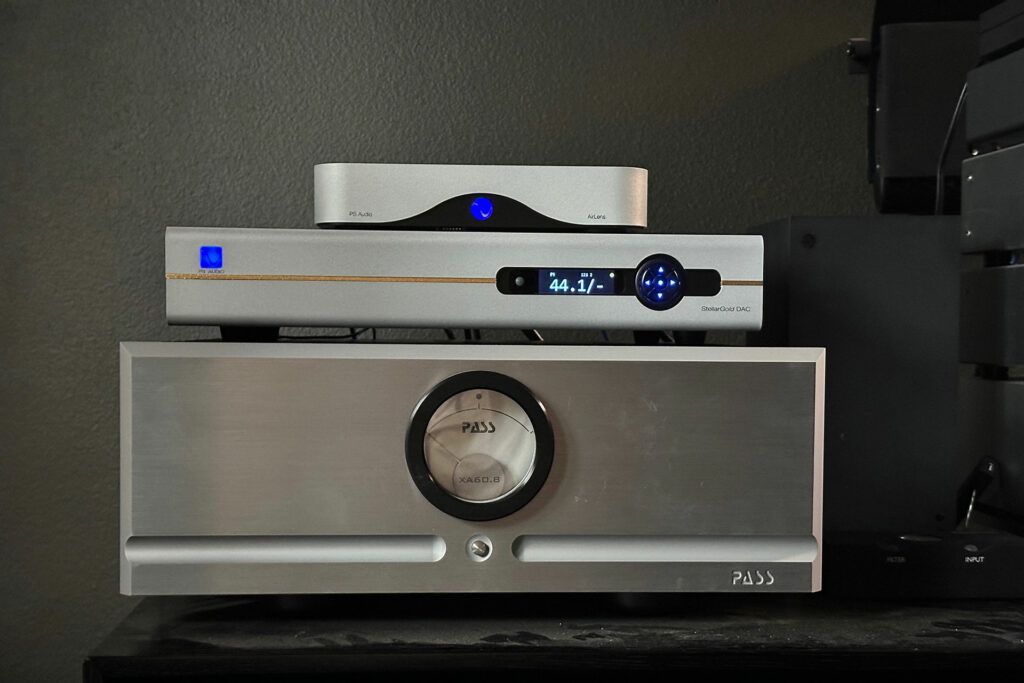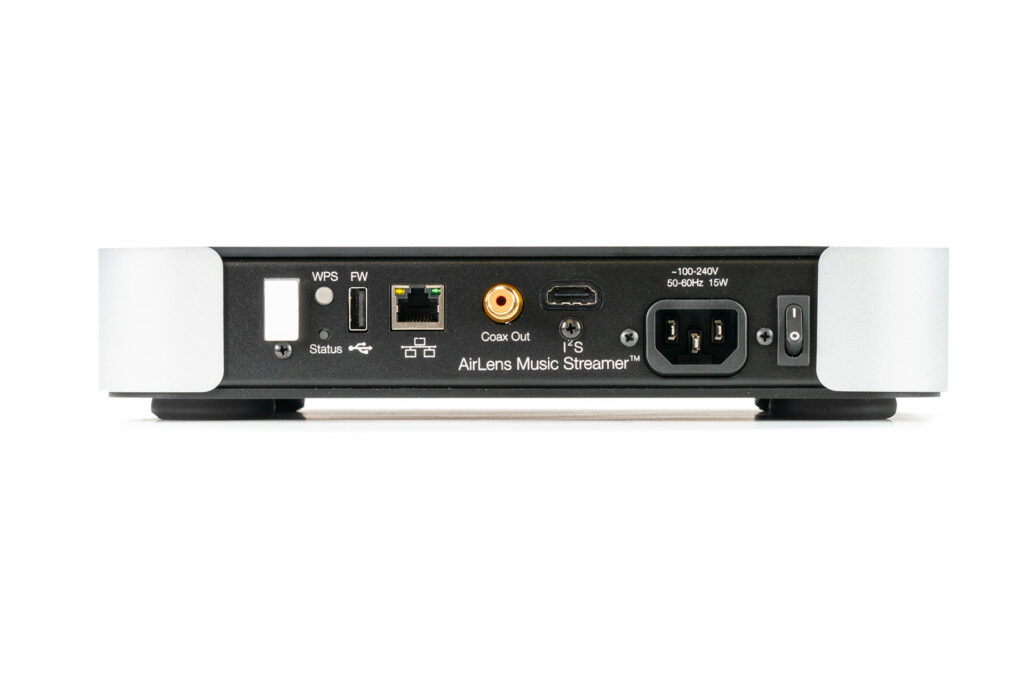The PS Audio AirLens retails for $1,999 and is a single-component audiophile streamer often referred to as a “network transport.” This is not to be mistaken for a streaming DAC, which is alternatively known as a “network player” that includes an internal DAC (digital to analog converter). The PS Audio AirLens, or any network transport, for that matter, is a computer specializing in and dedicated to retrieving digital music files from either a compatible streaming service subscription or digital music files stored on your network. The Network Transport processes real-time, continuous, low-latency digital data output for an outboard DAC. Some Network Transports include a proprietary music management application that integrates various streaming services into the software, with a companion mobile App for mobile device control. Other network transports often have no application, like the PS Audio AirLens, that relies on the native application of Tidal or Spotify through the Connect feature integration.
Most streamers (not all), including the PS Audio AirLens, are Roon Ready, meaning they are certified by Roon to work with the Roon app, audio processing and file management system, the Roon Core, which would replace a proprietary music file management and streaming service integration application. Consumers who are serious about music streaming often turn to Roon, since their audio processing is considered superior if it is set up correctly. The Qobuz and Tidal streaming services are embedded within Roon, and accessible by the AirLens, if the user follows that path. I use both Qobuz and Tidal through Roon, so that is how we will test the AirLens.
You might be surprised to learn that there are quite a few high-end Network Transports on the market, many of which are more expensive than the AirLens and, going far further in price, as high as $25,000 in my cursory research. With few exceptions, $2,000 is around the starting point for a dedicated, well-thought out and engineered purpose-built audiophile streamer. So, what makes a streamer high-end, and how does the PS Audio AirLens fit into this puzzle? Let’s find out…

What Makes the PS Audio AirLens Streamer So Special?
- The PS Audio AirLens design employs galvanic isolation, eliminating any electrical conduction path between the input and output stages. PS Audio claims this will eliminate ground loops, noise and jitter. While there are different methods of galvanic isolation, PS Audio implements optical isolators, which means an optical path to isolate noise.
- PS Audio uses its Digital Lens technology, which stores digital music data in a variable RAM (Random Access Memory) buffer. The data is re-clocked by a precision low-jitter fixed clock before reaching the digital output, so that your DAC receives a perfect digital stream free of noise with ultra-low jitter.
- PS Audio uses an I2S digital output, which Philips developed over 10 years ago, and has supported its use for other manufacturers. Its technology transmits data and clock information on separate leads within the HDMI cable for superior digital information transfer. As you can imagine, the receiving DAC must have an I2S input to take advantage of this feature. A second digital coax S/PDIF output on the AirLens ensures mass compatibility with all DACs.
- The PS Audio AirLens audio interface supports PCM up to 32 bits and 384kHz, Native DSD up to DSD256 on the I2S output, or DSD converted to PCM (DOP) and native DSD128 on the coax output.
- Music Streaming service compatibility includes Spotify Connect, Tidal Connect, and Roon Ready certification, whereas Qobuz and Tidal are embedded.
- The PS Audio AirLens can connect to the Internet using either a wired Ethernet cable with a 10/100/1000 Ethernet input, or wirelessly through the WIFI IEEE 802.11 b/g/n/ac standards, and operate in dual-band 2.4 or 5 GHz. PS Audio prefers a wired connection, since WIFI is susceptible to more noise.
- In use, the PS Audio AirLens was flawless in respect to glitches and ease of connectivity. In experimenting with various streamers, especially the lower-priced units, smooth operation is not guaranteed, nor should it be taken for granted.
- A carefully selected switching power supply with ultra-low noise and heat is part of the design, adding an important element to the AirLens design specs as a digital audiophile source component.
- The PS Audio AirLens looks great and weighs almost five pounds, due to its burly yet stylish thick metal casework, which is available in silver or black. The fit and finish are luxurious and conform with PS Audio design cues.
Why Should You Care About the PS Audio AirLens Streamer?
There are two main reasons why the PS Audio AirLens is a significant component. First, as mentioned earlier, PS Audio goes to great lengths to control noise and maintain digital timing, as previously explained. Combined with the I2S digital output via HDMI, the PS Audio AirLens uses novel technology to improve performance.
Second, PS Audio is a high-value, consumer-direct business pricing model based in the United States, with an inside dedicated sales team and a 30-day trial period. Manufacturers of similar quality streamers are typically not consumer-direct. I could find only one other company with a similar business model, but they are based outside the United States, which I will discuss in the competitor section below. Perhaps there are more, but they are unknown to me.
When considering both criteria, PS Audio has a unique niche within the marketplace.

Some Things You Might Not Like About the PS Audio AirLens Streamer…
- I would have preferred a full-width component. For me, the AirLens would be a primary source for my system and, as such, I would want it displayed prominently, which in my mind means its size should be in line with other significant components. If the AirLens was an all-in-one component where adding speakers is all that is needed, I could understand a smaller form factor. But that is not the situation here. The AirLens requires connection to a DAC and possibly a preamplifier, as in my setup. So, it would have been nice if the unit lined up nicely with these other components. It’s not a deal breaker, but it’s worth noting.
- A display to show the status of the firmware version, Internet connectivity, and signal strength if using WIFI, maybe Internet connection speed, streaming service, artist and track information, would have been a nice touch. In discussing the design objective with PS Audio, the goal was to keep the component as simple as possible, to control noise. Adding anything other than needed opens up vulnerability to inducing noise into the signal path. Connecting a display module that would require connection to a shared power supply opens up that possibility. For example, offering an HDMI output to connect to a monitor display to show artists and track information would have been nice. Still, that could have induced unnecessary opportunities to lower performance. For me, this is not a decision criterion, but worth noting.
- PS Audio does not provide a proprietary music library management system integrating the leading streaming services and a companion mobile app for control, which could be a concern. However, it is not an issue if you are a Roon user.
Listening to the PS Audio AirLens Streamer…
I recently completed a review of the Orchard Audio Pecan Pi+ streaming DAC. I was impressed with the overall performance and DAC capabilities, with its implementation of the AKM VelevetSound Veritas DAC components. To provide some context, I listened to the Pecan Pi+ as a whole, and then implemented the AirLens with the DAC portion of the Pecan Pi+, using its coax digital input. With this approach, I could single out and compare the streamers, with the DAC remaining constant. The Orchard Audio Pecan Pi+ easily connected to my reference audio system consisting of a Pass Labs XP 22 preamplifier, wired to a set of Pass Labs XA60.8 high-current monoblock amplifiers, operating in full Class-A mode up to 60 watts at eight ohms, doubling power at four ohms, and again at two ohms. Focal Kanta No. 2 floorstanding speakers would be the final stage of my system, creating a highly resolving platform for the AirLens to project its capabilities. The system benefits from Wireworld Eclipse 8 speaker cables, interconnects, and Electra 7 power cables for the amplifiers. I used Roon to stream, using both Tidal and Qobuz streaming services.
I listened to at least 50 recording artists on their various tracks, starting with some of my go-to testing songs that I know well, so that I could quickly identify differences, and differences there were. I toggled back and forth on each track between the streamer within the Pecan Pi+ and AirLens. While I cannot comment on every track, I will focus on a couple, but I noticed my experiences were consistent.
With the AirLens in play, using a 24/44.1 stream from Qobuz through Roon, on Adele’s latest album 30, the track “Can I Get It” offered an incredibly silent background. Perhaps silent is a poor word choice, since the Pecan Pi+ is not noisy or anything of that nature, but the AirLens had a level of dark or quiet that was quite notable. I could more easily hear a dimension of instruments and voices from the rear wall forward, creating an airy soundstage more significant than the Orchard Audio Pecan Pi+ alone and past streaming DACs I had had in my listening room. Imaging was comprehensive, with elevated discernable instrument and vocal placement. There was a definite increase in detail, displaying subtle instrumental cues not previously heard with the Pecan Pi+. Individual instruments had more structure and detail, especially in the guitar string frequency range. But the most noticeable improvement was in the voice. Adele’s vocals sounded smoother and more natural than my memory recalled. All of us have an acoustic memory of our favorite songs, whether conscious or subconscious, where we anticipate the upcoming sound characteristics. When we remember a bit of bold or edgy characteristic, we mentally prepare for it. When that memory never comes as the song plays, we notice and become more relaxed with less fatigue, which I experienced here. The sound quality I took for granted was inferior to what I was now experiencing, with smoothness and sweetness that I had not previously experienced. That says something. It is clear to me that the AirLens was making a difference. Yet, it should not be construed as a criticism toward Orchard Audio Pecan Pi+, since a $900 price point for a Streamer and DAC represents a genuine bargain, given its performance.
In Billy Joel’s song “Innocent Man” from the album of the same name, with a 24-bit, 96kHz FLAC stream, Joel gives us a chance to hear his broad vocal range from soprano to baritone low. The vocals sounded crisp, without any fatigue, and there was excellent separation off the backdrop of the front wall, while finger snaps were clear and intelligible, with his piano front and center. I cannot recall this song ever sounding better on my system than through the AirLens, at least until I took the system up another notch by adding in the Stellar Gold DAC that PS Audio sent along with the AirLens.
With the Stellar Gold DAC in place using the I2S output, I could hear added resolution across the entire track, even greater separation between instruments, and the additional airy quality I sense in a live event. That also applies to Joel’s voice, which was a pleasure to experience.
With the PS Audio Stellar Gold DAC in place, I revisited several songs, including the Adele song previously described. When I thought I had hit nirvana with my system, it continued to improve, suggesting that the PS Audio AirLens and Stellar Gold DAC are an excellent pairing I wish every audiophile could experience.
Will the PS Audio AirLens Streamer Hold Its Value?
I am not confident that any computer-based component like a network player will hold its value as well as more traditional audiophile electronics, since it has electronics that improve yet cost less over time. Additionally, streaming technology is still a relatively newer part of audio and will continue to evolve. While I am unsure how streaming would improve, history tells us human ingenuity prevails. However, we know the AirLens works well today and will continue to do so, regardless of the future, and therefore should hold its value relatively better than ordinary streamers.

What Is the Competition for the PS Audio AirLens Streamer?
The Volumio Rivo is a network streamer priced at $1,099. Rivo means stream in Italian, which makes sense, since Volumio is based in Italy, where the Rivo is manufactured. I included the Volumio Rivo, since it shares a few similarities to the PS Audio AirLens, including a consumer-direct business model and galvanic isolation implementation. Digital outputs include coax and AES/EBU for PCM high-resolution 24-bit/192kHz output. A USB output support PCM up to 32-bit at 768kHz, and DSD256 (DSD DAC required). Other features include an HDMI output to display the user interface to your monitor, which is a nice touch, since there is no display. The Premium version of the company’s Volumio OS is included and integrates Spotify, Tidal, and Qobuz, and is Roon Ready. Wireless and wired Internet is available. AirPlay and Bluetooth 5.0 are supported. The casework is sleek and unique. Volumio’s consumer-direct product line, which offers a Network Transport at almost half the cost of the AirLens, should be of interest to everyone. I have yet to audition the Rivo, so I cannot comment on how well it performs compared to the AirLens, but it has piqued my curiosity.
The Lumin U2 Mini, with a retail price of $2,600, is just a short distance from the PS Audio AirLens retail price, with the same Network Transport functionality. The U2 Mini is a newer design for Lumin, replacing their U1 mini with updated processing, and includes Lumin’s quad clocking for precise data timing. Playback up to 32 bits and 768kHz, as well as DSD512, is supported through the USB digital output. Coax, optical, AES/EBU, and digital outputs support up to 24-bit 192kHz of high-resolution data. One exciting feature is Leedh processing for lossless digital volume control. Typically, DACs possess digital or analog volume control. Still, here, the U2 mini streamer possesses higher-end digital technology that uses a lossless algorithm for unfiltered or changed digital data for your DAC to process, which may not matter if you intend to connect directly to a dedicated preamplifier for volume control. Regardless, the Lumin U2 Mini packs many features for the user. The excellent casework follows fit and finish quality from the top-of-the-line Lumin products.
Aurender takes streaming music seriously, which can be seen with five Network Transports in their lineup, starting with the entry-level N150, which retails for $3,500, all the way up to their $25k N30SA two-piece separate power supply streamer. Their starting point, N150, is still $1500 more than the AirLens and is simplistic in its design, with just two USB digital outputs requiring a USB DAC (a DAC with a USB input). USB is notoriously known to be noisy, and Arender deals with the issue with a double isolated gigabit network Ethernet input, since that is where noise and jitter would enter the component. A nice feature is a user-installable storage tray for an SSD or HDD for music storage. As we have seen, the usual music streaming service suspects are supported: Tidal, Qobuz, and Internet Radio through the Aurender Conductor App. Spotify Connect and AirPlay are also supported. All major codecs and formats up to 32-bit, 384kHz, and DSD512 native are compatible. An OLED display shows track information, which is a nice touch. The fit and finish are excellent.

Final Thoughts on the PS Audio AirLens Streamer…
The PS Audio AirLens is only for some. It is not for the mainstream-streaming, non-audiophile consumer who uses one of the two streaming services providing 44 percent of the world’s streaming, Spotify and Apple Music, which mostly don’t offer a path to high-resolution streaming. In that spirit, the AirLens does not cater to features that audio enthusiasts will not use, such as AirPlay2, Bluetooth, or a proprietary music management application that integrates popular streaming services. I am surprised the AirLens has WIFI. But enough with what the AirLens does not have.
Who is the AirLens for? The AirLens is for the audio enthusiasts who appreciate the magic of high-performance music streaming and are willing to follow a stricter path to achieve it. PS Audio recognized who their customers were by focusing on them and addressing the noise and jitter issue, from causes including computers, the Internet, and peripherals, by employing their technique and path to accomplish their goal, and they nailed it.
I thoroughly enjoyed my time with the PS Audio AirLens, which provided a gateway to noticeably higher performance. Nothing I have auditioned to date has rivaled what I experienced with the PS Audio AirLens, especially when mated to their Stellar Gold DAC. My goal now is to figure out how to keep the PS Audio AirLens in my system, because I don’t want it to go back.




Well written and I totally agree, being a vinyl guy I wanted a streamer to upgrade from my Bluesound Node.
Once I changed out my pre to the Stellar Gold and my CD player to the Stellar Gold Dac and PST SACD Transport it was a natural progression to get the AirLens and I dont regret it at all.
I don’t use all the streaming services I just want the best sound from the best sources, Qobuz is providing that with the AL, I do wish I could have access to some internet radio but I could get Roon if only it was more affordable.
The sound with the SGD is really really good, the bass in particular is well defined and clean as is the rest of the presentation. I am comparing to a 20K vinyl system.
Well Done PS Audio!
I can’t tell if that USB port is audio out or just a connection for USB external drives or firmware upgrades. (I wondered if “FW” above the port means “firmware.”)
If I2S and coax are the only actual signal outs, this is useful with many fewer DACs than is any Sonore, Aurender, Lumin, or just about any lower-end product.
That is a great point. It was a nonissue since I had a PS Audio DAC, which I could connect by SPIF or I2S. I suspect that PS Audio expects that their customer for this product would most likely be using one of their DACs, and if so, I2S would be the way to go. I discussed the decision process of outputs and other features, such as a screen, with PS Audio, and the answer was to limit noise and interference and control costs. Each additional output or feature requires additional internal components and drivers that open the system to noise. Aurender, since you mentioned them, for example, use USB, but they admit that the USB is a noisy connection. However, they go to great lengths to work around it with isolation techniques, etc. Every manufacturer will have its path. But to your point, the AirLens will put kick itself out of contention if your DAC selection requires USB.
Personally, I think that these devices are not very useful and are just “specialized” computers without the versatility/universality of a real computer. PS Audio’s in particular, since it needs an external DAC, the noise processing is not prohibitive at its level… It’s better for the DAC to be top-notch in every respect, including noise.
What’s more, most of these devices are only capable of processing stereo. So there’s no chance of them processing multichannel audio internally. A simple Mac Mini, through its OS, can decode and output 6 to 8 channels of Atmos audio from the Apple Music platform! No streamer can do this. It has an HDMI output, so you can downstream extract all channels in AES if required through a dedicated audio interface, and send the video signal to a screen or video projector! Last but not least, it’s easy to manage via RealVNC or screen sharing without a mouse or keyboard…
It can be used not only for audio, but also for video, either through a browser as with Netflix, or a dedicated application.
It’s easy to upgrade, and benefits from all OS evolutions over time. And it’s also easy to optimize for audio-video…
The icing on the cake: it’s less expensive than most streamers on the market!
IMHO…
“When we remember a bit of bold or edgy characteristic, we mentally prepare for it. When that memory never comes as the song plays, we notice and become more relaxed with less fatigue, which I experienced here. The sound quality I took for granted was inferior to what I was now experiencing, with smoothness and sweetness that I had not previously experienced.”
Excellent observation from a veteran listener! THAT says a lot as I experience the same from memories (and really all of us that know what to hear for). It shows that humans do have excellent and nuanced memories. Hugely important in listening or reviewing audio.
This is very kind of you to say!
I finally replaced my iFi Zen Streams with an Air Lens last week. The iFi sounds great, especially with a linear power supply, but useability is awful, however, and I don’t have enough hair left to deal with it. Tidal Connect keeps disconnecting and even mConnectHD drops frequently.
I plugged in the Air Lens to my Benchmark DAC3 via coax, network via a CAT6 cable and power. By the time I opened the iPad, Tidal Connect had found it. I hit play and… wowsers. I also checked and mConnectHD found it as well. For anyone who thinks bits are bits and all digital sources sound the same, you’re just wrong.
Highly recommended.
I’ve owned a few of those Benchmark DAC3s. Great.
The Airlens is solid too.
Your system is getting BAD-ASS.
—-
I JUST got the comments back from PS Audio on the pending review of their PMG (Paul McGowan) reference preamp. Jim Swantko has a $50,000 CH Precision and was BLOWN AWAY by the PS Audio. That’s a good sign.